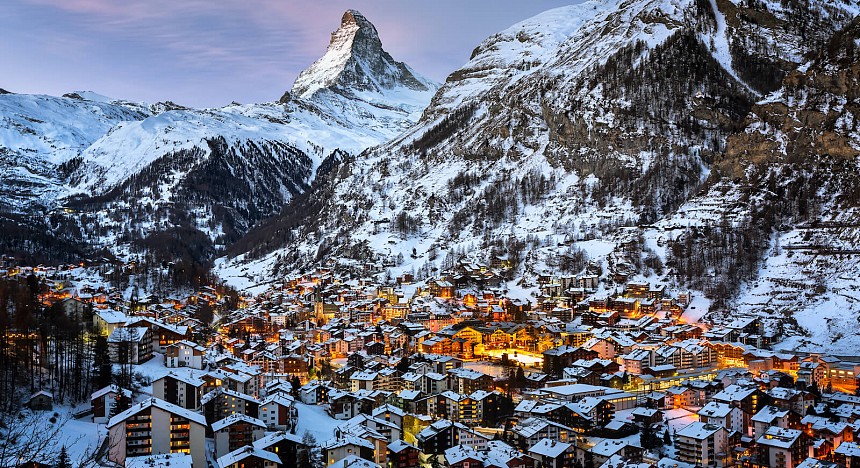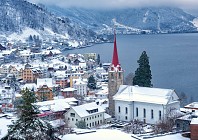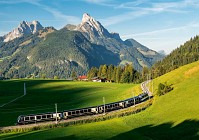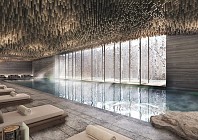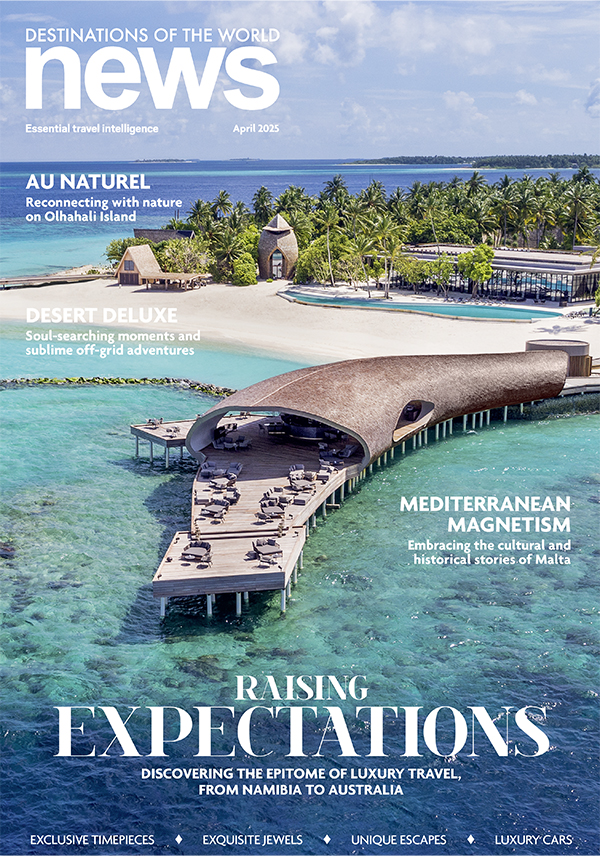I sip another spoonful of the fragrant goulash, made not with beef, but water buffalo that’s been raised right here in landlocked Switzerland. Normally found in Asia’s subtropical forests, 15 of the formidable bovids graze on pastures 30 miles away in Susten. “It’s a very healthy and lean meat,” hotelier Sandrine Julen explains as I take a bite out of Zermama Bistro’s herb and flower dusted water buffalo tartare; a standout dish from their new lunch menu. As a descendant of one of Zermatt’s founding families, Julen can now add a herd of organically-farmed buffalo to her list of assets!

Best known for its deep-rooted ski culture and mountaineering history, car-free Zermatt – in Switzerland’s southern Valais canton – started out as a tiny farming community at the end of a remote valley. Fast forward four centuries and the resort’s restaurateurs, chefs and entrepreneurs are looking local, thinking green and embracing the alpine food traditions that sustained Zermatt’s earliest inhabitants. Zermama Bistro’s meat and cheese platter is a tribute to the latter. It features seasoned beef (trockenfleish) from Sandrine’s family’s own Eringer cattle that’s been air-dried in ancient speichers: stilted storage barns built from local larch. Fuelled by good food and conversation, I make tracks for the great white outdoors. With 220-miles of snow-sure pistes and fifty on-mountain restaurants, there’s no danger of going hungry or repeating runs here! I resolve to find my ski legs on Zermatt’s sun-drenched south-facing slopes, reached via the Sunnegga funicular opposite Hotel Zermama’s namesake bistro.

-i8qlhv.jpg)
Swapping skiing for steaming in the shadow of the Matterhorn, I dethaw my frost-bitten thighs in the spa of Zermatt’s original (self-styled) palace. Named after the town’s famously crooked peak, Mont Cervin Palace’s a snowball’s throw from the town’s thrumming thoroughfare: Bahnhofstrasse. In a magical scene straight out of a snow globe, I find my head scattered with an ephemeral crown of snowflakes as I marvel at the moon rising over the Alps from the hotel’s whirlpool. Back inside, the 20-metre pool (reputedly the town’s longest) is skirted by loungers, where it’s all too easy to drift off, I discover. The sprawling 1,700-square-metre spa’s subterranean level, meanwhile, is a labyrinth of scented steam rooms and saunas, where covering up is strictly verboten.


Another choice spot to warm-up (wearing as many layers as you wish!) is in the fireside armchairs of Joseph’s Bar & Terrace. A vision in velvet, studded leather sofas and huge arched windows, its oysters to go (available during the winter season only) are the ultimate indulgent post-ski snack. Joseph’s is one of the hotel’s five restaurants, which include Michelin-starred Ristorante Capri and wood-fire-scented Grill Le Cervin. Despite the property’s palatial proportions, it still manages to marry cosiness with an ultra-personalised service. With 150 rooms and suites spanning four interconnected buildings, it’s hard to believe that this grand dame started out as simple lodgings with just 14 beds. The storied address has been welcoming esteemed guests, including world-famous cellist Pablo Casals and musician Phil Collins (who celebrated a milestone birthday here), since 1852. In 2019, billionaire hotelier and vintner Michel Reybier snapped up the hotel, bringing forth a series of sensitive renovations. The stuffiness may have been snuffed out, but satisfyingly, the old-school hospitality lives on. Just hours earlier I was picked up from Zermatt’s train station by the hotel’s horse-drawn antique carriage, which clippety clopped 400 metres along the lively Bahnhofstrasse. Nestled all too temptingly across the street from Zermatt’s Lindt Chocolate Shop is my south-facing Alpine Junior Matterhorn Suite. It’s housed in Mont Cervin Palace’s Villa Margherita wing, that’s tethered to the main building by a glass-covered walkway.


A three-minute hop and slide along Zermatt’s main drag delivers me to my dinner date: Potato Fine Food Restaurant. Opened briefly in 2020, the eccentric eatery didn’t hit its stride until the summer of 2021, when covid restrictions were finally relaxed. Friendly waiting staff flit between its three glass-fronted floors, serving a ‘surprise’ fortnightly-changing menu (priced at 149 CHF for five courses). Whilst the humble spud may be the restaurant’s muse, it’s by no means the sole ingredient. Seasonal Swiss produce such as homegrown caviar, Zermatten goat cheese, regional truffles, Alpine trout and Valais-grown blueberries are all sourced within a 60-mile radius. As for potato lovers, the canton’s native häärdepfil variety make their way into dishes like the Arctic char and Beef filet. Determined to work off last night’s excesses, I prepare to hit the slopes the next morning, first getting my kit on in Mont Cervin Palace’s cavernous ski room. As well as vaunting a cosy lounge, it’s outfitted with the Rolls-Royce of ski lockers, customised with hooks and snazzy shelves for every imaginable bit of ski apparel.

One of the best places to feast off Zermatt’s pistes is in Findeln: a foodie’s favourite which transforms into a well-trodden hiking trail come late spring. A welcome pop of orange in an otherwise all-white landscape, mod-chalet-styled Adler-Hitta is positioned midway along Sunnegga-Findeln’s blue run (number 6). The 2,200-metre-high restaurant’s charismatic Zermatten owner Urs Zumtagwald (known as Ugi) greets ski suited and booted patrons like old friends from its 120-cover terrace, which affords unobstructed views of the mighty Matterhorn. Practically everything on the hearty menu is homemade; from the barley cream and local cured meat soup to the bacon, leek and cheese spaetzle (a Swiss-German pasta dish). I tuck into their house speciality: a wood-fire-roasted, free-to-roam rotisserie chicken, sourced just over the border in Lombardy’s Valle Spluga. Considering Zermatt’s proximity to Northern Italy, it’s no great surprise to discover that its neighbour has left an imprint on the resort’s culinary scene, including its interiors. High-end Italian espresso machine makers La Marzocco were behind the alpine-industrial look of Zermatt Kitchen. As well as housing an onsite patisserie, the centrally located brunch spot hosts a raft of coffee workshops including a new sensory class. “You can brew coffee like tea,” Czech-born Marián Podola says as I bury my nose in some freshly bagged coffee. The Zermatt transplant’s early experiments roasting beans in the basement of Denner (the town’s discount supermarket) have clearly paid off. Founder and CEO of The Zermatt Kollektiv AG, Podola’s expanding empire includes a soon-to-be-opened third restaurant. “Roasting coffee is a craft,” he tells me, continuing, “but ceramics is an even older craft.”

The following day I trade Zermatt’s pristine pistes for a potter’s wheel at Zermatt Kitchen’s sister-restaurant-cum-ceramics-studio: Aroleid. Located in the chocolate-box hamlet of Furi (reached via a seven-minute cable car ride), the contemporary mountain chalet is surrounded by rustic timber barns that have been blackened by centuries of sun. “I love wheel throwing. It’s meditative,” in-house ceramicist Ruta Katiliute says as she shows me the messy art of ‘shaping’ in the first of two classes. Continuing my skiless afternoon, I return to the Zermatt-Furi gondola station, that’s located a 10-minute stroll from my next check in.

Cast from wood, metal and glass, The Omnia stands sentinel over the town on a rocky shelf at the foot of the Matterhorn. The entrance to the all-balconied-room hotel is equally breath-taking, not to mention Bond-esque. Glass doors open to a mountain-cut cave, along which an electric taxi shuttles guests to a glass elevator that whisks you up to the lobby-lounge-slash-library. Within minutes I’m devouring juicy olives (grown just over the border) and quaffing welcome bubbles from Switzerland’s UNESCO-listed Lavaux vineyards by a crackling fire. Rooted in place, large-format B&W photographs by homegrown talent Balthasar Burkhard hang from its walls, whilst custom-built Swiss furnishings adorn its communal areas.

It’s not only being elevated 45 metres above town’s roofline that immerses you in nature, but the property’s masterful use of materials like grey granite, blonde wood, slate and cedar bathtubs. Picture windows and canted roofs, meanwhile, make the most of Zermatt’s glorious alpine light. And bringing the big mountain drama even closer is the ultimate suite amenity: a Swarovski telescope! My airy and all-neutral Village Suite’s generous footprint features a separate living room, walk-through closet and luxurious bathroom stocked with cosmetics by Australian-founded Aesop. Resisting the urge to duck under my Tempur mattress’ downy duvet for a snooze, I instead retreat to the hotel’s indoor-outdoor pool for some pre-prandial laps in the shadow of the Matterhorn. Diners will have to settle for open kitchen views at Omnia’s ground-floor restaurant, where Tony Rudolph turns out veggie-leaning fare, best described as experimental haute cuisine. The unexpected star of his surprise four-course, wine-pairing menu – which incorporates regeneratively-farmed meat and sustainably-sourced fish – is an oak-barrel-aged Heida hailing from nearby Visperterminen’s high-altitude vineyards.

More local libations await at Club Mamacita: a sultry South American-themed live music bar which opened its plum-painted doors on pedestrianised Bahnhofstrasse three years ago. It may be blowing a blizzard outside, but that doesn’t stop me from sipping on a spritz! Christened ‘Swiss Delight,’ head bar manager and mixologist Daniele Milani attributes the cocktail’s lawn-green colour to a little-known Swiss herbal liquor called Marito verde. It’s one of several recent additions to their imaginative drinks list, that draws inspiration from the country’s bountiful larder, as well as women like Helvetia: the female personification of Switzerland. The first run of my final ski day is in champagne powder: the lightest, fluffiest and airiest of them all! Framed by Zermatt’s famous four-thousander-peaks, the snowy scenes are made all the more spectacular by Europe’s highest tree line. Morphing from vibrant green to rust red, then veiled in white come winter, Zermatt’s lofty larches taste good too. Tapped for syrup, their baby cones are just one of the hyperlocal ingredients that are foraged (and in some instances fermented) by connoisseurs of casual fine dining: Brasserie Uno. The only restaurant in the Valais to hold both a Michelin Star and a Michelin Green Star, in six short years they’ve become synonymous with sustainability.

With just 28 covers, the dining space is equal parts homey and quirky. Sheepskin furs are slung over the backs of reclaimed chairs, a distressed dresser lined with blue-white vintage plates stands in the corner, whilst a wine-rack – upcycled from wooden skis belonging to the owner’s late grandfather, Uno – hangs on a wall. Splicing seasonally-harvested ingredients with inspiration from around the globe, highlights (at the time of my visit) of their six-course degustation menu included a marinated root vegetable ceviche, green gazpacho and rice-less risotto made from organic Swiss-grown rye. Impressively, the team’s commitment to low waste goes beyond their ‘leftover tomato crisps’. To save on precious paper, Mexican Head Chef Luis Romo and owner Andreas Alm weave storytelling magic with their oral menus, whilst kitchen scraps are turned into compost for their three Zermatt kitchen gardens. My trip too, it seems, has come full circle. The following day I find myself trundling back down the valley, snatching one final glimpse of the Matterhorn as its snaggle-toothed profile eclipses the sloping sunlight…
Mont Cervin Palace
+41 27 966 88 88
www.montcervinpalace.ch
The Omnia
+41 27 966 71 71
www.the-omnia.com
